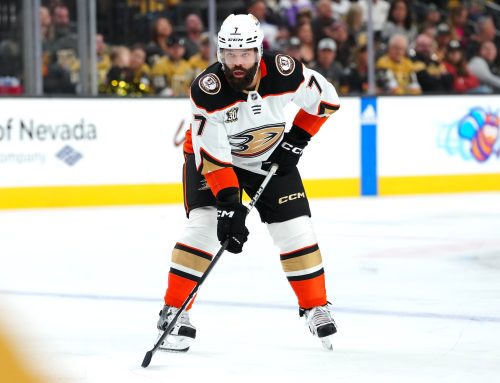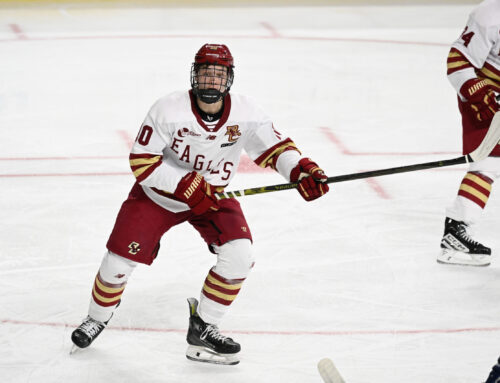
Following the signing of Zach Werenski, it seemed pretty obvious that Charlie McAvoy would soon follow. Less than a week later, McAvoy signed a three-year deal with Boston coming in with an AAV just under $5-million. As with a few of the bridge deals we’ve seen lately, the final year has a significantly higher actual salary than the earlier seasons.
In my mind, McAvoy is already a top-15 defenceman in the NHL. The problem for fantasy hockey is that as long as Torey Krug is around, McAvoy won’t be on the top PP unit. Beyond that, he hasn’t shown a penchant for shooting, which means we’re relying on even-strength points and hits/blocked shots for value. That’s a pretty narrow range of value in roto leagues when we’re talking about a player being drafted around other guys who at least have an opportunity for PP1 minutes like Jacob Trouba, Shea Theodore, and Dougie Hamilton.
*
I’ve been stressing it all off-season, but Andreas Johnsson is going to be one of the best values in fantasy this year. He’s lining up with Auston Matthews and William Nylander right now and I believe he’s going to be in the top-6 all season (even when Zach Hyman returns). Finally, as mentioned before, I think he’s going to be the fourth forward on the top PP unit. We know Mike Babcock doesn’t really like to change his lines, so there is every opportunity for Johnsson to explode for 70 points this year. Fair warning.
*
Chicago had Toews, DeBrincat, and Kane all on different lines in their inter-squad scrimmage on Sunday. Might be something, might be nothing. Let’s wait and see what lineups look like when players start getting cut.
*
As of now, Filip Chytil looks to have the inside track for the second-line centre job with the Rangers. If he does win that job, and the Rangers go with the planned top line of Panarin-Zibanejad-Buchnevich, that would leave Kreider and Kakko for Chytil to play with. Not bad. Of course, there is lots of time between now and the regular season, still.
*
While the Ducks have been shuffling their lines all camp so far, one line that has stuck together is Rakell-Steel-Silfverberg. That’s good news for Steel dynasty owners but bad news for Rakell owners in any format. I like Steel as a prospect, but there’s a Grand Canyon-sized chasm between his value for wingers and Ryan Getzlaf’s value for wingers. Could be good news for Max Comtois, though, a guy I wrote about recently.
*
Let’s talk about arbitrage.
In fantasy sports, arbitrage is simply the act of passing on drafting a player near their given ADP to draft a player much later you can think perform similar to the first player. It’s effectively looking for a savings in ADP because a given player is under- or over-valued. I wrote about this last year and I went 1-for-3, though Jake DeBrusk had a fine injury-shortened season himself. Even with 82 games he wouldn’t have come close to Gabriel Landeskog’s value however, so that’s a miss by me.
Anyway, being able to find those guys later in drafts who can put up very good seasons is important, as is not over-paying for someone with similar stats much earlier in the draft. Here are some guys that I’ll be drafting over some others. I’m going to try to avoid players I’ve droned on about incessantly this offseason like Dylan Larkin, Kyle Palmieri, Johnsson, Timo Meier, Ryan Ellis, and others.
Also, we’re talking Yahoo! standard leagues here, which includes hits but not PIMs or blocks.
Jake Muzzin over Drew Doughty
We’ve seen very recently that teams are capable of supporting three fantasy options from the blue line, with Nashville and Calgary being prime examples in the last few seasons. Typically, these have to be high-scoring teams, the players have to be talented, and there has to be a specific area where the lesser player excels. With Nashville in 2016-17, Ryan Ellis had a shooting percentage spike, while in 2015-16 it was an assist spike for T.J. Brodie in Calgary. Lucky, sure, but it’s an area to excel; every defenceman can’t play PP1 at the same time, so they need value elsewhere.
Enter Jake Muzzin, Doughty’s former teammate. After coming over from Toronto, Muzzin put up 16 points in 30 games, along with over two shots and two hits per game. Those are very stout totals which, if put up over a full season, make for a top-20 defenceman. I wouldn’t want to rely on a 30-game sample, but considering Muzzin has put up at least two shots per game in every season from 2013-2018 and two hits per game in every season from 2013-18 except for 2016-17 (and even then it was 1.98 hits per game), I don’t have a problem just rolling in that sample into Muzzin’s profile.
So, if we can rely on Muzzin for hits and blocks, what about those 16 points in 30 games? Well, from 2015-18, Muzzin’s individual points percentage (IPP, or the rate at which he garners a point when the team scores a goal with him on the ice) at 5v5 was 38.9 percent, and it was 39.3 percent with Toronto, which means that was completely in line. His on-ice shooting percentage (the team’s shooting percentage with him on the ice) was 8.95 percent on a team that shot 8.6 percent after his acquisition, so nothing out of line there either. The one thing that was high was secondary assists, but his primary assists were low, so it seems if those even out, it’ll just be more of the same.
I understand the reticence over drafting Muzzin because he’ll be stapled to the second PP unit while Doughty will get top PP minutes in Los Angeles, but it’s important to remember that the Kings are possibly the worst team in the NHL, certainly among the bottom-3, with almost no scoring and likely to trade Tyler Toffoli. I’ll draft the guy putting up good peripheral stats playing heavy even-strength minutes for the team that could score 100 more goals than Los Angeles this year, and I’ll draft him several rounds later, thanks.
Max Domi over Joe Pavelski
Nearly across the board, Domi out-produced his norms last year. He shot 14.5 percent at five-on-five, by far a career-high, his IPP at 5v5 was a career-high, and his on-ice shooting percentage was also a career-high. The thing is, we’re comparing this to his time in Arizona, when the Coyotes were arguably the worst offensive team in the NHL.
Domi’s zone entries and exits with possession, which were good in Arizona, were elite with the Habs this year. It’s still a small sample, but this is what the last three years look like for Domi, split into 2016-18 and 2018-19:
.png)
While he may not be a defensive stalwart, Domi knows how to get the puck moving in transition, and playing with a guy like Jonathan Drouin, that’s a good thing. While we’d like them to be play-drivers, it does appear that at least Domi is the exception to the rule: he can drive goals without necessarily driving shot differentials. It’s not an easy thing to do, but we now have four seasons’ worth of data with Domi doing exactly this. Below is the Regularized Adjusted Plus/Minus (RAPM) charts from Evolving Hockey. The bar to the far left is offensive goals for, the rest are play-driving shots and expected goals. This is Domi in Arizona from 2015-18:

And here is Domi last year with the Habs:

It’s virtually identical to his first three years: driving goals and expected goals but bad defensively. I don’t normally feel comfortable saying a guy who has trouble driving shot differentials can drive goal scoring, but with four years of data, I feel comfortable saying that for Domi.
So now we get back to his 2018-19 season. We have a guy who we now know has a track record of driving goals, playing with a very good playmaker in Drouin, putting up four-year highs. With the benefit of hindsight, it’s really not all that surprising.
As of right now, these are my projections for Domi and Pavelski:
Domi: 26.9 goals, 42.6 assists, 16.1 PPPs, 216.1 shots, 63.5 hits
Pavelski: 30.1 goals, 37.0 assists, 25.2 PPPs, 215.3 shots, 51.7 hits
I do have Pavelski with a decided edge in PPPs but everything else is fairly similar. A lot of Domi’s PP projection is also based on Montreal’s power play last year, which was an absolute mess. If that improves, Domi’s numbers should as well. I’m willing to save 4-5 rounds of value on Pavelski to draft Domi and hope the Habs PP can right itself, not to mention he’s a decade younger.
Nino Niederreiter over Teuvo Teravainen
I thought it would be fun to put up a pair of line mates for a couple reasons. First, obviously, they were often line mates last year post-Nino trade. Second is that they both have dual-wing eligibility on Yahoo!. Third, there are several rounds of rankings difference between the two on both Yahoo! and ESPN. So, it’s worth looking at whether that several rounds’ difference is justified.
This is a case where the league settings matter. My projections currently have Niederreiter putting up more than double the hits (84) of Teravainen (37), and that’s very important. I also have Niederreiter putting up over 20 percent more shots than Teuvo, which is also important. All of Teravainen’s value in fantasy – well, most of it anyway – comes from his assists. In this area, I have Teuvo at 54 with Niederreiter at 36. I also have Teuvo with a small edge in PPPs, 23-19. So, again, we’re down to the type of league. If we’re including hits and shots, Niederreiter is the play. If we’re not, then it’s Teuvo.
But then we have to get rankings. On ESPN, Nino is outside the top-100 skaters while Teuvo is among the top-50, while on Yahoo!, Nino is ranked more than seven rounds later – assuming 12-team leagues – than Teuvo. Even if we were just talking points-only, the gap between Teuvo and Nino is difficult to explain. If we’re talking roto, there’s a good argument that Nino is outright more valuable than Teuvo, and Nino is going several rounds later. This is a no-brainer.
(just a small note: Niederreiter was skating with Aho in preseason lines and Teravainen was not)
The reason Niederreiter is going so late is because he wasn’t productive in 2017-18 and there’s less than a half-season of data to work with in Carolina. But Niederreiter is one of the most underrated players in the league and is easily a top-line-calibre winger. Carolina is the smartest team in the NHL, which is why you saw Niederreiter’s ice time increase by nearly four minutes with the Hurricanes compared to earlier in the year with the Wild. I suspect that will maintain, and there’s no reason to draft Teravainen several rounds ahead of Niederreiter in any format.





 FLA
FLA CHI
CHI NYR
NYR PIT
PIT L.A
L.A COL
COL CAR
CAR OTT
OTT TOR
TOR T.B
T.B
 NYI
NYI MIN
MIN BOS
BOS CBJ
CBJ ARI
ARI
